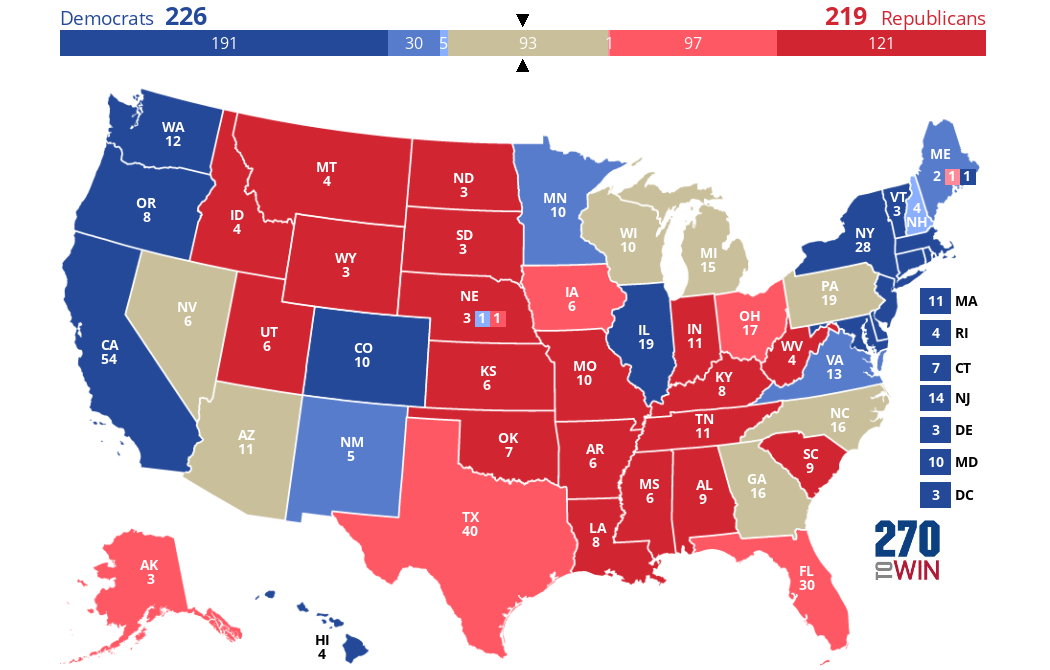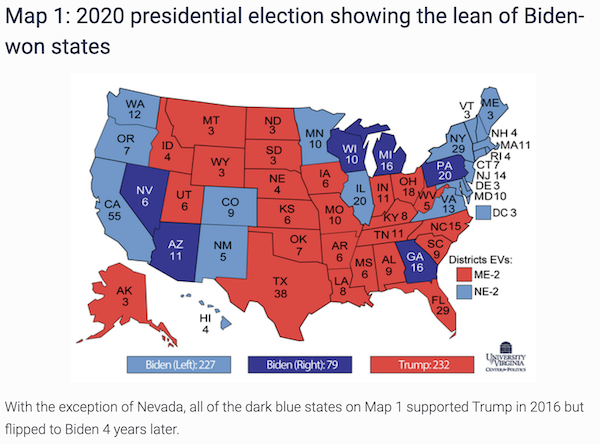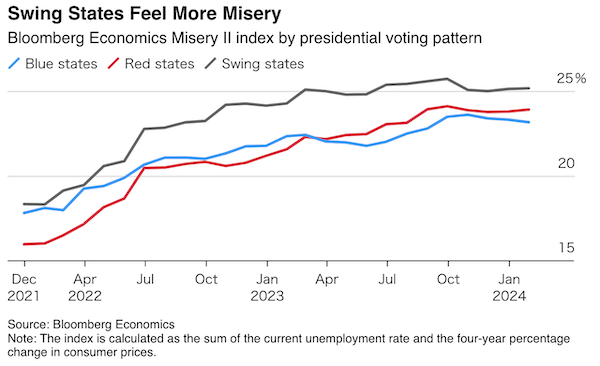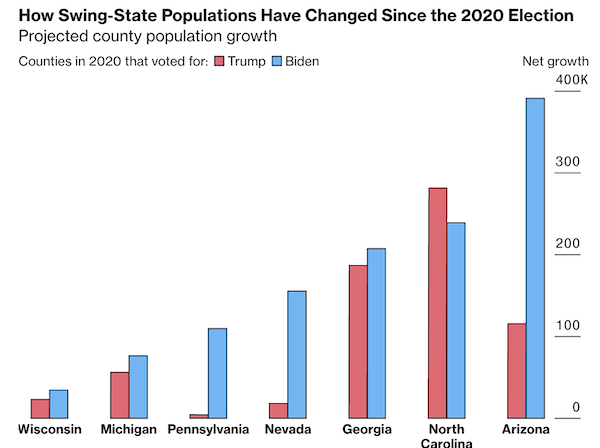By Lambert Strether of Corrente.
Everybody talks about swing states, but nobody does anything about them. In this essay I will list (easy) and define (a little contested) swing states, and explain why they matter in election 2024. Then I’ll present concerns that transcend swing states (surprisingly few), followed by concerns refracted through particular swing states (surprisingly many). In a subsequent post I will go into detail about particular swing states (to the extent that the horrid state of search allows).
Most press coverage frames election 2024 as “horse race” between two candidates: Biden and Trump (this random headline, “Biden Takes Down Trump With 3-Word Punchline At DC Roast,”[1] is typical of the mentality). Polls determine which horse is ahead. There are a few problems with this. For one thing, election 2024 is, at the very least, a five-way race: Biden, Kennedy, Trump, West, and Williamson. For another, the polls are contested, especially this early in the season (dull normal Americans famously don’t focus on electioneering until after Labor Day). From the Economist, a fine example of contestation:
The election is still nine months away. Historically, polls taken before the summer of an election year have been poor predictors of results. But no former president has sought to return to office since the advent of modern polling. Opinions about the omnipresent Mr Trump are much firmer than they are about typical challenger candidates, who at this stage of the race are usually still fighting to secure their party’s nomination. As a result, even though Mr Trump is not yet the presumptive Republican nominee, current head-to-head polls between him and Mr Biden may be unusually informative.
But surely about Biden, too? That said:
Some pollsters are consistently more accurate than the field. But there are many ways to judge quality. The Economist’s general-election polling average weights polls solely by sample size and recency, so larger and newer polls contribute a greater share to the overall score. On this basis, Mr Trump leads Mr Biden in national polls by 2.3 points. That compares with a 0.2-point lead for Mr Biden in an unweighted average that gives polls from six months ago the same weight as those from this past week. The size of Mr Trump’s lead varies widely by the quality of pollster.
Certainly an interesting perspective from a clever publication. But I think all the digits can be boiled down to one conclusion: The election is close. But we knew that.
Finally, the poll-driven horse-race perspective tacitly assumes that leading in the polls means winning the election, as if the United States had a national popular vote. It does not. Under Federalism (see Article II, Section 1, Clauses 2 and 3), states do, their votes are aggregated to determine a winer, and at this point I’m going to resort to a great slab of material from a FAQ at the National Archives, and pray to whatever Gods there be that we don’t actually have to understand this stuff between Election Day and the Inaugural[2]. For those who want to skip the FAQ, and for those who imagine they already undertstand it, GOTO END_FAQ; and if you are still reading, the electoral college (like, say, the “Kollege of Musical Knowledge”) is not a place, but a process:
What is the process?
The Electoral College process consists of the selection of the electors, the meeting of the electors where they vote for President and Vice President, and the counting of the electoral votes by Congress.
How many electors are there? How are they distributed among the States?
The Electoral College consists of 538 electors….
Spoiler: 538 / 2 = 269! So there could be a tie (in which case the election is thrown into the House, another exciting scenario).
A majority of 270 electoral votes is required to elect the President. Your State has the same number of electors as it does Members in its Congressional delegation: one for each Member in the House of Representatives plus two Senators….
The District of Columbia is allocated 3 electors and treated like a State for purposes of the Electoral College under the 23rd Amendment of the Constitution. For this reason, in the following discussion, the word “State” also refers to the District of Columbia and “Executive” to the State Governors and the Mayor of the District of Columbia.
How are my electors chosen? What are their qualifications? How do they decide who to vote for?
Each candidate running for President in your State has their own group of electors (known as a slate). The slates are generally chosen by the candidate’s political party in your State, but State laws vary on how the electors are selected and what their responsibilities are. Read more about the qualifications of the electors and restrictions on who the electors may vote for.
What happens in the general election? Why should I vote?
The general election is held every four years on the Tuesday after the first Monday in November. When you vote for a Presidential candidate you are actually voting for your candidate’s preferred electors.
Most States have a “winner-take-all” system that awards all electors….
At this point, we raise the question of “faithless electors.” More:
…to the Presidential candidate who wins the State’s popular vote. However, Maine and Nebraska each have a variation of “proportional representation.”
What happens after the general election?
After the general election, your State’s Executive prepares a Certificate of Ascertainment listing the names of all the individuals on the slates for each candidate. The Certificate of Ascertainment also lists the number of votes each individual received and shows which individuals were appointed as your State’s electors. Your State’s Certificate of Ascertainment is sent to NARA [(National Archives and Records Administration)] as part of the official records of the Presidential election.
Speculating freely, but presumbly anybody who interrupted the process of sending the Certificates of Ascertainment to NARA could be charged with interfering with an official proceeding. For some definition of “interrupted.” More:
The meeting of the electors takes place on the first Tuesday after the second Wednesday in December after the general election. The electors meet in their respective States, where they cast their votes for President and Vice President on separate ballots. Your State’s electors’ votes are recorded on a Certificate of Vote, which is prepared at the meeting by the electors. Your State’s Certificate of Vote is sent to Congress, where the votes are counted, and to NARA, as part of the official records of the Presidential election.
Each State’s electoral votes are counted in a joint session of Congress on the 6th of January in the year following the meeting of the electors. Members of the House and Senate meet in the House Chamber to conduct the official count of electoral votes. The Vice President of the United States, as President of the Senate, presides over the count in a strictly ministerial manner [not, until recently, tendentious!] and announces the results of the vote. The President of the Senate then declares which persons, if any, have been elected President and Vice President of the United States.
The President-elect takes the oath of office and is sworn in as President of the United States on January 20th in the year following the general election.
END_FAQ: So that is the apparatus of the Electoral College. You can see at once that winning votes, per se, does not win the Presidency. Winning votes in states does that. And some states are more equal than others. From Roll Call:
If you really want to identify the voters most likely to pick the next president, you can forget about strong partisans from competitive states [New York, California, Texas, etc.]. It’s swing voters from the swingiest states, like Arizona, Georgia, and Wisconsin, who will really matter if the race for the White House is close [as this race, today, is].
So what matters is precisely what “horse race” coverage does not cover. Now let’s look at what swing states are.
What Are Swing States?
Amazingly, not everybody agrees which states are really swing states. From the Telegraph:
The classification of “swing state” is not official, and pollsters disagree over which states are most important for candidates going into each race.
Broadly speaking, a swing state is where both major parties enjoy similar levels of support among the voting population – with the Democrats and Republicans within a few percentage points of each other in polls.
In this presidential race, the critical states are likely to be Arizona, Florida, Georgia, Michigan, Nevada, North Carolina, Wisconsin and Pennsylvania.
So that is eight states: The estimable Cook Political Report has six, not eight: Arizona, Georgia, Michigan, Nevada, Pennsylvania, and Wisconsin (but not North Carolina or Florida. Infinite are the arguments of mages). Meanwhile, RealClearPolitics (RCP) goes with seven:
So at RCP, we have states from the Northeast (Pennsylvania), the Great Lakes (Michigan, Wisconsin), the South (Georgia, North Carolina), and the West (Arizona, Nevada). That’s a pleasing grouping! I think the RCP list is the best, because it does not include Florida (making Florida a swing state implies facts not in evidence, i.e., a functioning Democrat Party), and does include North Carolina (Democrats there seem to be making a fight of it). As you can see from the RCP chart, Trump is leading, which worries the Democrats (they worry a lot), even though poll quality is low (except perhaps for internal polling, which costs a lot of money, and which we will never see).
Here are RCP’s seven swing states in the form of a handy map:

You can see at once that this map for 2024 is very similar to the map for 2020:

Similar except for the candidate who is, at this point, winning, of course.
One useful aspect of the swing state perspective is that it limits the field for squillionaires; it’s easier to invest in seven states than all fifty.
General Concerns for All States
Election 2024 has three (at least three) aspects that apply across the board, nationally (although both party apparatuses would doubtless like the nationalize the election as much as possible with their respective talking points[3]). They are: Double Hater Voters, and Events. Let us take each in turn.
Double Hater Voters. From The Daily Beast:
Move over swing voters, independents, NASCAR dads, and soccer moms. So-called “double-haters” might be the most important voting bloc this year.
In case you missed the memo, “double-haters” are voters who don’t like either Donald Trump or Joe Biden. This is an emerging cohort that many of us can identify with (although I try not to venture into “hate” territory).
Every year, we are treated to a plethora of news stories about undecided voters. You know the cliché: people who are socially liberal and fiscally conservative. Because these voters (who somehow manage to make it through life without picking a team) are persuadable, they get a ton of ink and disproportionate attention from politicians. If you like receiving voter mail, tell a canvasser you’re not sure which candidate you like—but that you definitely plan on voting.
Well, double-haters are undecided voters on steroids—at least, in terms of their size. Generally speaking, undecided voters constitute around 10 percent of voters nationwide, while double-haters constitute a whopping 19 percent, or nearly one-fifth of the electorate, according to three separate, respected polls. Obviously, these disaffected voters are likely to have a major say in choosing our next president.
Especially in a 3-, 4-, or 5-way race (depending on ballot access), and even more especially in swing states. (I haven’t found any evidence that Double Haters are concentrated in swing states, so place this concern here).
Events, Dear Boy, Events. 1968 was full of “events.” President Lyndon Baines Johnson (LBJ) declined to seek re-eleciton in March 31. Martin Luther King was assassinated on April 4. Robert F. Kennedy was assassinated on June 5. The Democratic National Convention on August 22–30 was a debacle (I well recall seeing the Chicago cops clubbing an anti-war priest to the ground. I had stayed up late to watch on a black-and-white televsion, and the the priest’s robes contrasted strongly to tear gas.) And we had only one war going on at the time! I don’t see any reason to think that 2024 would be any less volatile, given the right, er, triggers. And then of course the Republicans nominated Nixon (“tanned, rested, and ready“), who won. Such events would clearly nationalize the election, though to what end I cannot know.
Particular Concerns in Swing States
I was surprised to find that many aspects of 2024 that I thought would apply nationally turn out to need a swing state lens. Let’s look at Economics, Demographics, and Taylor Swift (!).
Economics. As it turns out, “the economy” is actually worse in swing states than it is in the country as a whole. From Bloomberg:
The Bloomberg Economics Misery II index — an analysis of cumulative inflation rates over four years, plus the latest unemployment rate — illustrates how differing economic conditions across the US can impact the electoral vote.
The index is higher in the battleground states of Arizona, Georgia, Michigan, Nevada, North Carolina, Pennsylvania and Wisconsin than in those that reliably vote either Republican or Democratic in presidential elections.
There also are lots of different ways voters might think about the economy. Biden’s team doubtlessly is hoping a soft landing will help voters forget about the surge in costs for their weekly shopping.
Our suspicion, though, is that voters have long memories on inflation. If that’s right, our Misery II index should be a good guide to how economic conditions will shape the vote.
— Stuart Paul, US Economist
I’ll say. Joe Biden owes me six hundred bucks. Bloomberg provides a handy chart:

More:
Over the past 60 years, the national Misery II index has averaged 17.95% in election years when the incumbent party retained the presidency. It’s now just over 23%.
Demographics. Bloomberg on population shifts:
The population shifts are more pronounced in some battleground states than others, and they don’t uniformly favor Biden. But in aggregate, they offer a reason for optimism for the president’s campaign, even as polls show him trailing his likely opponent, Donald Trump: A Bloomberg analysis of state population forecasts found swing-state counties that Biden won in 2020 will have on net gained almost twice as many people by election day as those that voted for Trump.
Handy chart:

Taylor Swift. I had to. From the Guardian:
What is true, though, is that Swift currently possesses unprecedented power: an endorsement from the most beloved [gad] singer in the United States could potentially tip the balance in what’s likely to be a close election. A reported billionaire, Swift can reroute economies, trigger congressional action and spur tens of thousands of people to register to vote. While her endorsement is unlikely to sway a voter who is undecided between Trump and Biden – if such an American exists – experts believe Swift could convince people who don’t feel energized by Biden to vote for him anyway.
But whether Swift will wield that power or instead stay out of the electoral fray remains unclear. Although Swift endorsed Democrats in 2018, she has in recent years increasingly withdrawn from such overt displays of partisanship or making controversial statements. That change that has coincided with her return to the top of the celebrity food chain and, in the process, left some Swifties feeling like their idol could do better.
Interestingly, somebody went to the trouble of measuring interest in Swift in the swing states:
Taylor Swift’s new (and existing) fans have sent Google searches around the popstar up by 216% across the swing states. So how could this affect the election?
By analysing search trend data over the past year, AceOdds has calculated which states have had the highest surge of Taylor Swift fans and compared them with the latest poll results and the number of electoral votes available to reveal where her influence may hold the most power in the election.
A handy chart:

Four of our seven. Looks like Swift would have to move a lot of votes from Trump’s column to Biden’s. But maybe she can! And maybe the race is even tighter than we think.d
NOTE: There are other aspects that, like a Trump conviction and “the youth vote” that I don’t at this point know whether to use a national or a swing state lens; so I omitted them for now. Identity verticals (Blacks, Muslims, etc.) vary strongly by state, and will be covered, for swing states, in the next post.
Conclusion
I hope readers have enjoyed this superficial romp; in the next post, I’ll go more deeply into individual states, where the really interesting detail is to be found. Readers, if you can recommend local sources on electoral politics — blogs, weeklies, columns, newsletters, twitter accounts — please list them in comments (or send them to me in mail). These sources will be useful to me not only for the companion post for this post, but throughout the election season. Thank you!
NOTES
[1] One can only wonder whether this year’s Gridiron Club shindig was also a superspreader event.
[2] Allow me to introduce the contrarian thought that a national popular vote, especially if done digitally, would be a single point of failure. #JustSaying.
[3] For Democrats, abortion, a success for them in the midterms; for Republicans, immigration. On abortion, Trump seems to be trying to steal the Democrats clothes (why not just say “safe, legal, and rare“?); Biden is doing the same on immmigration. (I confess that I see immigration as a labor market issue, driven by the effects of the Covid pandemic on the working class, not a salient aspect of either party’s discourse.)


